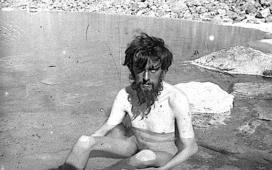The Olympic Games have their origins in antiquity, but their modern revival has also been going on longer than any of us has been here. Even the fifth Summer Olympics, which took place in Stockholm in 1912, has passed out of living memory. But thanks to the technology of the twenty-first century, we can call up surprisingly crisp footage of its competitions any time we like, much as we’re doing with that of the currently ongoing thirty-third Summer Olympics in Paris. One especially fascinating use of these resources, for those invested in sporting history, is to compare the performances of Olympic athletes over time: we know they’ve improved, but it’s one thing to see the numbers, and quite another to see a side-by-side comparison.
Take the venerable men’s 100 meters, whose 1912 and 2020 finals both appear in the video above. 112 years ago, the United States of America’s Ralph Craig won the day (after seven false starts, and arguably an eighth as well) with a time of 10.8 seconds. Three years ago (Tokyo 2020 having been delayed by COVID-19 to 2021), the victor of that same event was Italy’s Marcell Jacobs, who crossed the finish line at 9.8 seconds.
An even greater evolution manifests in the javelin throw, in which the Swedish Eric Lemming’s 60.64 meters in 1912 becomes Neeraj Chopra’s 87.58 meters in 2020. (Nor has Chopra finished setting records, at least judging by the media fanfare in his homeland that attended his recent arrival in Paris’ Olympic village.)
Pole vaulting, too, has undergone a great leap forward, or rather, upward. Just above, you can see the 1912 record of 3.95 meters set by Henry S. Babcock of the United States, then the 2020 record of 6.02 meters set by Armand “Mondo” Duplantis of Sweden — or technically, of both Sweden and the U.S., having been born and raised in the latter, but able to represent the former due to his mother’s being Swedish. In recent decades, such cases of nationally mixed parentage (the American-born Italian Jacobs being another) have become more common in the Olympics, which in that and other respects has long reflected changes in the wider world. And though whether humanity is improving on the whole remains a matter of heated debate, we’ve undeniably been getting a lot better at running, throwing, and jumping with the aid of big sticks.
Related content:
The Science of the Olympic Flame; Ancient Style Meets Modern Technology
The Story Behind the Iconic Black Power Salute Photo at the 1968 Olympics in Mexico City
Did Joe Strummer, Frontman of The Clash, Run the Paris and London Marathons?
Based in Seoul, Colin Marshall writes and broadcasts on cities, language, and culture. His projects include the Substack newsletter Books on Cities and the book The Stateless City: a Walk through 21st-Century Los Angeles. Follow him on Twitter at @colinmarshall or on Facebook.















